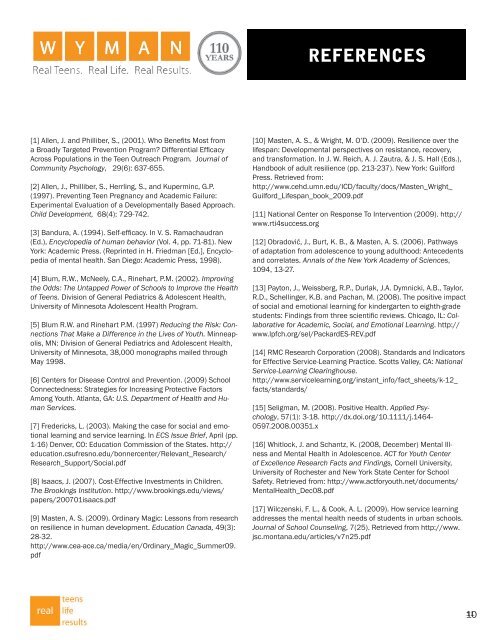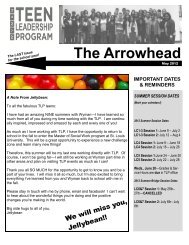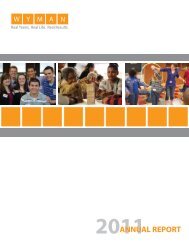promoting mental health & well-being in adolescents - Wyman
promoting mental health & well-being in adolescents - Wyman
promoting mental health & well-being in adolescents - Wyman
You also want an ePaper? Increase the reach of your titles
YUMPU automatically turns print PDFs into web optimized ePapers that Google loves.
REFERENCES<br />
[1] Allen, J. and Philliber, S., (2001). Who Benefits Most from<br />
a Broadly Targeted Prevention Program? Differential Efficacy<br />
Across Populations <strong>in</strong> the Teen Outreach Program. Journal of<br />
Community Psychology, 29(6): 637-655.<br />
[2] Allen, J., Philliber, S., Herrl<strong>in</strong>g, S., and Kuperm<strong>in</strong>c, G.P.<br />
(1997). Prevent<strong>in</strong>g Teen Pregnancy and Academic Failure:<br />
Experi<strong>mental</strong> Evaluation of a Develop<strong>mental</strong>ly Based Approach.<br />
Child Development, 68(4): 729-742.<br />
[3] Bandura, A. (1994). Self-efficacy. In V. S. Ramachaudran<br />
(Ed.), Encyclopedia of human behavior (Vol. 4, pp. 71-81). New<br />
York: Academic Press. (Repr<strong>in</strong>ted <strong>in</strong> H. Friedman [Ed.], Encyclopedia<br />
of <strong>mental</strong> <strong>health</strong>. San Diego: Academic Press, 1998).<br />
[4] Blum, R.W., McNeely, C.A., R<strong>in</strong>ehart, P.M. (2002). Improv<strong>in</strong>g<br />
the Odds: The Untapped Power of Schools to Improve the Health<br />
of Teens. Division of General Pediatrics & Adolescent Health,<br />
University of M<strong>in</strong>nesota Adolescent Health Program.<br />
[5] Blum R.W. and R<strong>in</strong>ehart P.M. (1997) Reduc<strong>in</strong>g the Risk: Connections<br />
That Make a Difference <strong>in</strong> the Lives of Youth. M<strong>in</strong>neapolis,<br />
MN: Division of General Pediatrics and Adolescent Health,<br />
University of M<strong>in</strong>nesota, 38,000 monographs mailed through<br />
May 1998.<br />
[6] Centers for Disease Control and Prevention. (2009) School<br />
Connectedness: Strategies for Increas<strong>in</strong>g Protective Factors<br />
Among Youth. Atlanta, GA: U.S. Department of Health and Human<br />
Services.<br />
[7] Fredericks, L. (2003). Mak<strong>in</strong>g the case for social and emotional<br />
learn<strong>in</strong>g and service learn<strong>in</strong>g. In ECS Issue Brief, April (pp.<br />
1-16) Denver, CO: Education Commission of the States. http://<br />
education.csufresno.edu/bonnercenter/Relevant_Research/<br />
Research_Support/Social.pdf<br />
[8] Isaacs, J. (2007). Cost-Effective Investments <strong>in</strong> Children.<br />
The Brook<strong>in</strong>gs Institution. http://www.brook<strong>in</strong>gs.edu/views/<br />
papers/200701isaacs.pdf<br />
[9] Masten, A. S. (2009). Ord<strong>in</strong>ary Magic: Lessons from research<br />
on resilience <strong>in</strong> human development. Education Canada, 49(3):<br />
28-32.<br />
http://www.cea-ace.ca/media/en/Ord<strong>in</strong>ary_Magic_Summer09.<br />
pdf<br />
[10] Masten, A. S., & Wright, M. O’D. (2009). Resilience over the<br />
lifespan: Develop<strong>mental</strong> perspectives on resistance, recovery,<br />
and transformation. In J. W. Reich, A. J. Zautra, & J. S. Hall (Eds.),<br />
Handbook of adult resilience (pp. 213-237). New York: Guilford<br />
Press. Retrieved from:<br />
http://www.cehd.umn.edu/ICD/faculty/docs/Masten_Wright_<br />
Guilford_Lifespan_book_2009.pdf<br />
[11] National Center on Response To Intervention (2009). http://<br />
www.rti4success.org<br />
[12] Obradović, J., Burt, K. B., & Masten, A. S. (2006). Pathways<br />
of adaptation from adolescence to young adulthood: Antecedents<br />
and correlates. Annals of the New York Academy of Sciences,<br />
1094, 13-27.<br />
[13] Payton, J., Weissberg, R.P., Durlak, J.A. Dymnicki, A.B., Taylor,<br />
R.D., Schell<strong>in</strong>ger, K.B. and Pachan, M. (2008). The positive impact<br />
of social and emotional learn<strong>in</strong>g for k<strong>in</strong>dergarten to eighth-grade<br />
students: F<strong>in</strong>d<strong>in</strong>gs from three scientific reviews. Chicago, IL: Collaborative<br />
for Academic, Social, and Emotional Learn<strong>in</strong>g. http://<br />
www.lpfch.org/sel/PackardES-REV.pdf<br />
[14] RMC Research Corporation (2008). Standards and Indicators<br />
for Effective Service-Learn<strong>in</strong>g Practice. Scotts Valley, CA: National<br />
Service-Learn<strong>in</strong>g Clear<strong>in</strong>ghouse.<br />
http://www.servicelearn<strong>in</strong>g.org/<strong>in</strong>stant_<strong>in</strong>fo/fact_sheets/k-12_<br />
facts/standards/<br />
[15] Seligman, M. (2008). Positive Health. Applied Psychology,<br />
57(1): 3-18. http://dx.doi.org/10.1111/j.1464-<br />
0597.2008.00351.x<br />
[16] Whitlock, J. and Schantz, K. (2008, December) Mental Illness<br />
and Mental Health <strong>in</strong> Adolescence. ACT for Youth Center<br />
of Excellence Research Facts and F<strong>in</strong>d<strong>in</strong>gs, Cornell University,<br />
University of Rochester and New York State Center for School<br />
Safety. Retrieved from: http://www.actforyouth.net/documents/<br />
MentalHealth_Dec08.pdf<br />
[17] Wilczenski, F. L., & Cook, A. L. (2009). How service learn<strong>in</strong>g<br />
addresses the <strong>mental</strong> <strong>health</strong> needs of students <strong>in</strong> urban schools.<br />
Journal of School Counsel<strong>in</strong>g, 7(25). Retrieved from http://www.<br />
jsc.montana.edu/articles/v7n25.pdf<br />
11 10








